[in
italiano]
[im
deutsch] |
|
The aim
of this paper is to ask a question: "What developments do we
hope to see in architecture over the coming years?" And, to make
the question more tangible, we mean the next years so that in 2006
we will be able to check what has actually been achieved.
The question appears to pass over an aspect that, far from being negligible,
is indeed crucial. We are talking about Digital architecture or
Computer and architecture only as a means of achieving a new
phase for architecture as a whole. The formula of the IT Revolution
in Architecture emphasises the rate of acceleration that we are currently
experiencing.
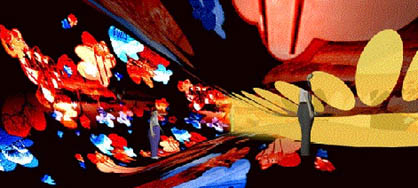
Oosterhuis.nl, Noord-Holland pavilion for the Floriade
2002 exhibition.
It has revolutionised the creation of every product in the modern
world, with evident economic and social repercussions, and it is now
ready, as this exhibition itself demonstrates, to become a subject
for reflection for all architects.
Before we even start answering the question about the developments
we hope to see, we must take a step back and draw a deep breath. The
run-up that I suggest making only has two stops: one in 1997, and
the other in 1926.
THE REDISCOVERY OF NARRATION. The new Bauhaus building was opened
in 1926. In Dessau all links with past building styles were drastically
severed. In particular, the new building ruled out any idea of a building
typology, of structural continuity, urban morphology, a perspective
framework, a historic style and lastly, a role as a cathedral understood
as a symbolic and communicative role attributed to architecture. This
was a painful elimination, especially because the image of a cathedral
created by Feininger was in the first programme for the school drawn
up by the new director in 1919. Walter Gropius also affirmed that
"the new building activities of the future… would rise towards
the sky like a crystalline symbol of a new faith being born."
(Stiftung Bauhaus Dessau, Margret Kentgens-Craig (Hrsg.), das bauhausgebäude
in dessau 1926-1999. Basel, Berlin, Boston 1998, p. 6)

Lyonel Feininger, Cathedral,
woodcut, cover of 1st program
of Bauhaus Weimar, April 1919.
Seen from the angle that interests us now, the key aspect is precisely
this disappearance of the cathedral. The architecture of the Modern
Movement could only communicate its function in tautological terms.
The end form was determined by meaningless abstract signs (pilotis,
the two-dimensional plane, the glass slot), put together, like pieces
of meccano, based on rules of pure syntax. Called by postmodern historiography
of "inibition" towards form, this approach was profoundly
motivated because it symbolised the way in which machines were conceived,
designed and constructed.
But when the objectivisation parameters for functions, the standardisation
of components, the uniformity of solutions, the serialisation of processes
and the entire industrial production system entered a period of crisis
(and it is well known that the crisis rampaged for most of the Seventies
and Eighties), aspects that had previously been excluded were reinstated.
In other words, the narrative, symbolic and communicative importance
of architecture.
The earliest sign of this process of re-introducing meaning and symbol
into a language derived from the Modernist movement appeared in Jørn
Utzon's project for the Sydney Opera House in 1956, but the process
only really gathered strength more recently. In particular, in 1997
it became evident for the first time to all that architecture had
reacquired its value as a means of public communication (or to use
the pejorative form: publicity communication). For a variety of reasons,
we have used the Guggenheim Museum in Bilbao as a marker of this change
(but the same could be said of the Amsterdam Science Museum or the
new wing of the Jewish Museum in Berlin). Today everyone goes to Bilbao
as if fulfilling a pilgrimage to this lay cathedral of culture designed
in a contemporary language. But what has this to do with digital architecture,
with the architecture of information, and above all with the future
and the developments we hope it will bring?
COMMUNICATION AND INFORMATION. This major comeback of communication
as the driving force behind a new phase of architecture is a fact
that is structurally linked to the IT revolution. It is an aspect
that is often underestimated and misunderstood.
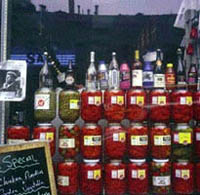
Fredy Massad, New York Spring, 1996.
The potato that we buy at the supermarket is 90% information (research,
marketing, distribution), the same is true to an even greater degree
of household appliances or cars and an increasing number of people
produce goods that are "pure" information. Information is
the real added value of any product. And what makes it competitive
is the real added value. Information also means narration, image and
design. Take a watch for example, or a car or even architecture. First
of all we buy the narration, the lifestyle utopia, then the form,
while the fact that the product works is absolutely taken for granted.
The container wins hands down over the contents.
NEW ISSUES. But, obviously, this first narrative and metaphorical
level is only the start and, we might say, that there is a very superficial
relationship between Architecture and the IT revolution that does
not affect the real issues at stake today. A parallel example of our
particular situation today can be found in Bruno Taut's Glashaus at
the Werkbund Exhibition of 1914.
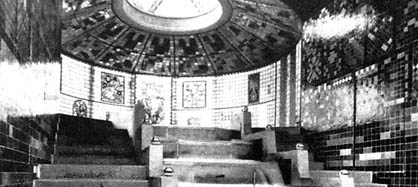
Bruno Taut, Glashaus, German Werkbund Exhibition, 1914
Cologne.
The use of glass and transparency was a romantic hymn at the time,
an expressive and poetic inspiration that had no influence whatsoever
on the real issues at stake. We have to wait until the Bauhaus movement
before it was understood how glass and transparency could act as the
catalysts for a new vision of architecture.
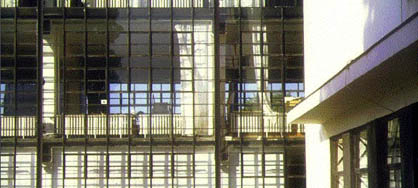
Walter Gropius, Bauhaus, 1926 Dessau.
In Dessau transparency becomes the issue of Gropius message. An aesthetic,
formative, practical, functional and philosophical issue. This underlines
Gropius's view that transparency is the objectivisation of function,
namely architecture's capacity to annul "every communicative aspect",
presenting itself alone. "Neue Sachlichkeit" would not have aesthetics,
but only ethics, if it were not for transparency.
THE NEW "HOW". A further comparison with Bauhaus is required here
because the architecture that will be built over the coming years
cannot avoid being overwhelmingly and dramatically different from
the Modern Movement. Gropius vanquished the five-headed dragon of
traditionalist architecture by adopting 1. free bodies adhering to
each function instead of a priori schemes for individual typologies;
2. a centripetal system of conquering space rather than closed blocks
on the road; 3. construction based on structural skeletons rather
than continuous walls; 4. a dynamic language instead of a figurative
one anchored to history and renaissance perspective and 5. the elimination
of every form of symbolism.
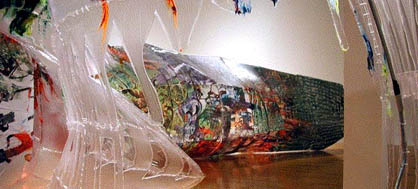
Greg Lynn FORM & Fabian Marcaccio, Installation The
Predator, for the show Suite Fantastique, The Wexner Center
for the Arts, Columbus Ohio, 2001.
Today we are trying to understand how the same elements discovered
by Gropius and declined in different forms by Mies or Mendelsohn and
others will radically change once again. And they will be forced to
change because, as was pointed out earlier, this outburst of technological
innovation will inevitably have repercussions on our field.
In his closing remarks at the 1930 Werkbund congress in Vienna, Mies
Van Der Rohe stated that: "New time is a reality; it exists irrespective
of whether we accept or reject it. It is neither better nor worse
than any other time, it is simply a fact and per se unaffected by
values. What matters is not 'what' but merely 'how'." (Fritz
Neumeyer, Mies van der Rohe. Das kunstlose Wort. Gedanken zur Baukunst.
Berlin 1986, p. 372)
My generation of architects and critics have started to piece together
quite a few ideas about the "how" concerning the New Time
of Information. Some of these are pretty clear-cut.

Pongratz+Perbellini Architetti, Piazza cittadella,
Verona.
The free unfurling of the functions that, from an industrial point
of view, represented the idea of an expanding machine now increasingly
tends to be replaced by a logic based on the space between. There
is a tendency to work "in between", also because we are
forced to do so by the presence of existing buildings. The idea of
efficient building structures and frameworks is replaced by the formula
"engineering is the art of the possible".
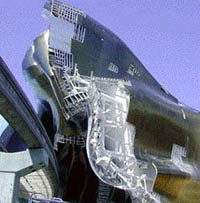
Frank O. Gehry and Associates.
Experience Music Project under
construction, Seattle, 2000
(photo Bruce Lindsey).

Frank O. Gehry and Associates.
CATIA drawing, The Peter B. Lewis
Campus of the Weatherhead School
of Management at Case Western
Reserve University in Cleveland
Ohio. Completion 2002.
Building takes any shape and is accomplished in any way. Take the
example of Bilbao again (also because in many cases building costs
represent a much smaller percentage than in the past), Gropius's centripetal
movement in space is replaced by many others based on the figures
of the palimpsest, spiral, partial emersions, supporting an idea of
space as a system of interacting forces between the interior and exterior.
There is no machine that expands freely into its surroundings, but
rather a series of interrelations between objects. Taken to an extreme
there are no more primary elements (atoms, functions or 2D planes),
but only "connections". Lastly, in a city which itself has been designed
as if it were an assembly line (this is where we live, work, rest
and spend free time), we are replacing it with an increasingly mixed,
hybrid, multifunctional city, open 24 hours a day and above all "anti-zoning".
ABOUT INTERACTIVITY. We are working towards a complete replacement
of Gropius's discoveries, not because we do not like them (on the
contrary, we continue to love them like we love Piero, Michelangelo
or Caravaggio) but because our modern world is totally different.
We are not wondering how to create architecture that makes superficial
use of information as communication or narration ? as happened during
the Nineties ? but on the contrary, how to ensure that information
becomes the very essence of architecture.
Now, if information (its classification, diffusion, transmission and
above all its formalisation) is the driving force behind change, and
if it is true that the motor that has enabled this new development
is the electronic digitalisation of data (in all fields and in all
sectors), it is also true that these two levels, albeit having an
enormous impact, would be non-existent without a thinking mind, which
is the true issue of the information revolution. It is well known
that this mind consists of the dynamic interconnection of data. Today
we have the capacity to create extremely mobile models governed by
one or more functions, which can generate different models just by
altering a single input of information. We are immersed in a cloud
of information that is constantly changing.

Frank O. Gehry and Associates.
CAD software being developed to
facilitate skin design.
A few years ago now we showed out how to translate this into architecture,
namely into apparently the most static thing that exists, and the
same was also done by a small group of pioneering architects, most
of whom are here today. It is called Interactivity and it will play
the same role as transparency in Gropius's new objectivity.
INTERACTIVITY. Interactivity in architecture means at least three
different things with increasingly levels of complexity, the most
complex of which, namely physical Interactivity, contains the first
two. But let us proceed in order. Physical interactivity means that
the architecture itself changes. We know that intelligent houses already
exist whose environment modifies according to the situation. There
is the hospitality setting in which some lights are automatically
dimmed, selected doors open, sliding partitions or false ceilings
are moved, and the temperature and air flow are adjusted accordingly.
Perhaps, and this is something that will become increasingly possible
following the introduction of microfibres for furnishings, glass and
some new marbles, even the physical characteristics of walls may interactively
change in texture, porosity, the capacity to absorb sound or colour.
Countless other scenarios are also possible. The application of these
ideas as part of a more widespread practice, using them not only in
affluent homes, as happens at present, but to an increasing extent
in public buildings, museums and in certain areas of the city is one
of the developments that we would hope to see in architecture over
the next five years. And by 2006 I am almost certain that we will
also see signs of a maturing "aesthetic" conscience in this
field.
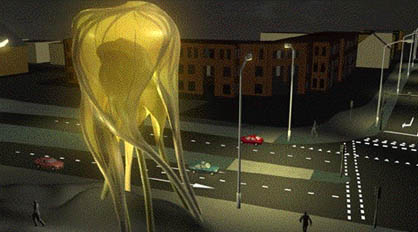
NOX (Lars Spuybroek with Pitupong Choawakul, Norbert
Palz, Wolfgang Novak and Joan Almekinders) with artist Q.S. Serafijn,
Interactive tower for the city of Doetinchem, 1998.
But in addition to the effective mutation of architecture, Interactivity
also involves two lower levels that are simpler to achieve. The first
is that today we can combine reality and the virtual in ways that
would have been inconceivable in the past. Advances in the projection
systems used almost under the skin of the building allow us to intervene
with a sort of new mass media illusionism bringing vitality to degraded
situations or circumstances in which it was impossible to intervene.
Interventions of this kind have been carried out on archeological
sites or in degraded suburbs or in some areas of historic city centres.
It represents a decisive step towards the presence of IT within the
city landscape and scenery. We predict the development of "an IT baroque":
of the new Piazza Navonas, the new Trevi Fountains and the new Trinità
dei Monti in 2006. We are working on it.
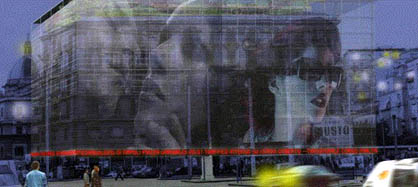
Gianni Ranaulo, Media building Pirelli - Milanocentrale
Spa, 1999.

IaN+ (C. Baglivo, L. Galofaro, S. Manna), Underground
Museum, Villa Medici, Roma.
Lastly, there is a third level that might be even more widespread.
This takes the form of interactivity within the process of architectural
design itself. Although few make effective use of this facility, it
is now possible to move rapidly and easily inside the cloud of interconnected
data that I described earlier, making ad hoc decisions regarding the
shape we wish to give to the cloud. The process of first conceiving,
then constructing and last of all managing architecture allows a massive
flow of interactivity.

Wombat (K. Jormakka, J. Gargus,
F. Jamil, M. Ramirez), trailer that can
take three habitable positions.
Deleuzian position.
We are gradually drawing closer to the dream-like vision advocated
by Chuck Eastman and other scientists working on Caad in the Seventies.
Namely, having a single database of 3D information on a building,
organised in hierarchical terms (therefore dynamically, as if it represented
a mathematical equation), linked to external catalogues, tariffs,
3D models of the components and connected to expert systems for specialist
tests. Efficiency is not the only advantage. Interactivity in the
design process also means creating an increasingly fluid way of achieving
the best possible architecture on each occasion. Certainly, in 2006
we hope for better architecture "tout-court", without adjectives,
which will undoubtedly be triggered by this level of interactivity
in the design process.
NEW SUBJECTIVITY. You will now understand why I used the term "New
Subjectivity" in the title, since of all the predicted outcomes this
is the most decisive. While the formula for the Modern Movement was
rightly "Neue Sachlichkeit", today's formula can only be "New Subjectivity".
Not "Existenzminimum", but rather an existence that is expanded and
enriched to make individuals into increasingly alive and free persons,
not just numbers in a statistical yearbook.

Peter Anders. Cybrid space in an architectural
office. Remote clients and consultants are ghost
like, architect is the woman. They are looking
at a model of a cybrid project. Both the model
and the architectural space are cybrids - part
material and cyberspaces.
If transparency provided the aesthetics and ethics, the reason and
the technique for a world that rationally wished to see the progress
of civilisation, and better standards of living for the vast masses
of workers in industry (and it succeeded!), I hope that interactivity
may serve to focus contemporary thought on an architecture that, having
overcome the objectivity of our needs, can respond to the subjectivity
of our wishes.
Antonino Saggio
|
|
[18jul2004] |














